公平减少儿童接触不健康食品营销的十种政策选择比较
IF 3
3区 医学
Q2 NUTRITION & DIETETICS
引用次数: 0
摘要
目的:减少儿童接触不健康食品营销的机会对于消除儿童肥胖症至关重要。我们旨在估算不同政策方案下儿童接触食品营销的减少量,并评估不同社会经济地位儿童接触食品营销的差异。设计:儿童接触不健康食品营销的数据来自之前的一项横断面研究,在这项研究中,儿童(n=168)连续四天佩戴可穿戴相机和 GPS 设备。对于每次接触,我们都确定了环境、营销媒介和食品/饮料产品类别。我们分析了十种政策情景下食品营销暴露减少的百分比,并按社会经济贫困程度进行了分类:1)无产品包装;2)无商品营销;3)无含糖饮料营销;4)学校无糖果营销;5)学校无含糖饮料营销;6)公共场所无营销;7)学校 400 米范围内无营销;8)娱乐场所 400 米范围内无营销;9)公交车站 400 米范围内无营销;10)主干道 400 米范围内无营销。环境:新西兰惠灵顿地区。参与者:168 名 11-14 岁的儿童:168 名 11-14 岁的儿童。结果儿童接触食品营销的情况因环境、营销媒介和产品类别而异。在 10 个政策方案中,减少最多的是普通包装(60.3%)、无含糖饮料营销(28.8%)和无公共场所营销(22.2%)。社会经济贫困程度没有差异。结论结果表明,普通包装能最大程度地减少儿童接触食品营销的机会。然而,鉴于儿童经常在多种环境下通过各种营销媒介接触到不健康的食品营销,因此需要全面的禁令来保护儿童的健康。本文章由计算机程序翻译,如有差异,请以英文原文为准。
Comparison of ten policy options to equitably reduce children’s exposure to unhealthy food marketing
Objective: Reducing children’s exposure to unhealthy food marketing is crucial to combat childhood obesity. We aimed to estimate the reduction of children’s exposure to food marketing under different policy scenarios and assess exposure differences by socioeconomic status. Design: Data on children’s exposure to unhealthy food marketing was compiled from a previous cross-sectional study in which children (n=168) wore wearable cameras and GPS units for four consecutive days. For each exposure, we identified the setting, the marketing medium and food/beverage product category. We analyzed the percentage reduction in food marketing exposure for ten policy scenarios and by socioeconomic deprivation: 1) no product packaging, 2) no merchandise marketing, 3) no sugary drink marketing, 4) no confectionary marketing in schools, 5) no sugary drink marketing in schools, 6) no marketing in public spaces, 7) no marketing within 400m of schools, 8) no marketing within 400m of recreation venues, 9) no marketing within 400m of bus stops, and 10) no marketing within 400m of major roads. Setting: Wellington region of New Zealand. Participants: 168 children aged 11-14 years. Results: Exposure to food marketing varied by setting, marketing medium and product category. Among the 10 policy scenarios, the largest reductions were for plain packaging (60.3%), no sugary drink marketing (28.8%) and no marketing in public spaces (22.2%). There were no differences by socioeconomic deprivation. Conclusions: The results suggest that plain packaging would result in the greatest decrease in children’s exposure to food marketing. However, given that children are regularly exposed to unhealthy food marketing in multiple settings through a range of marketing mediums, comprehensive bans are needed to protect children’s health.
求助全文
通过发布文献求助,成功后即可免费获取论文全文。
去求助
来源期刊

Public Health Nutrition
医学-公共卫生、环境卫生与职业卫生
CiteScore
6.10
自引率
6.20%
发文量
521
审稿时长
3 months
期刊介绍:
Public Health Nutrition provides an international peer-reviewed forum for the publication and dissemination of research and scholarship aimed at understanding the causes of, and approaches and solutions to nutrition-related public health achievements, situations and problems around the world. The journal publishes original and commissioned articles, commentaries and discussion papers for debate. The journal is of interest to epidemiologists and health promotion specialists interested in the role of nutrition in disease prevention; academics and those involved in fieldwork and the application of research to identify practical solutions to important public health problems.
 求助内容:
求助内容: 应助结果提醒方式:
应助结果提醒方式:


